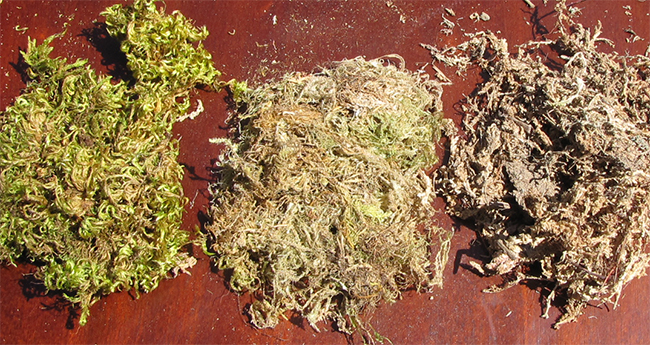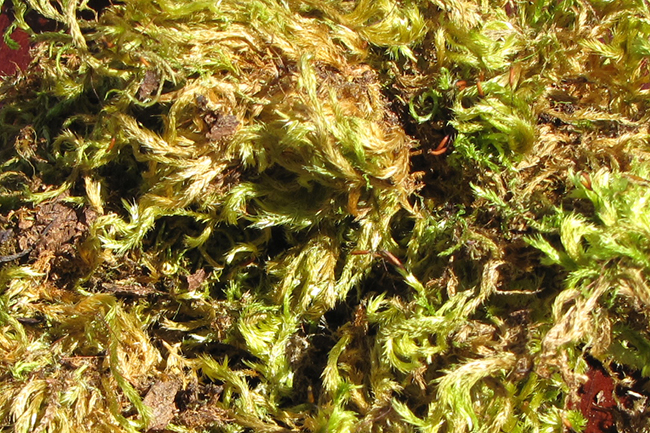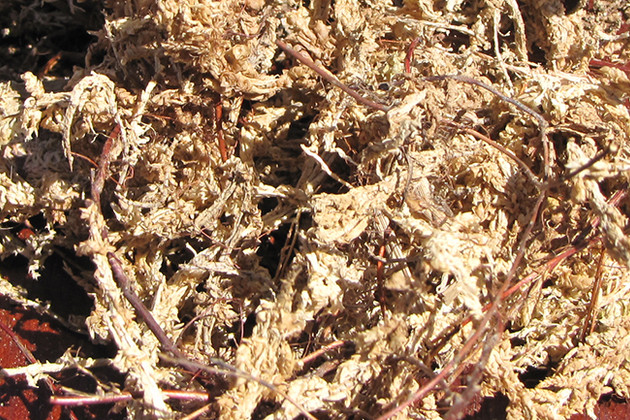Using Sphagnum Moss with Succulent Plants
Apr 15th 2012
Sphagnum moss can be an essential tool when planting succulents. It is commonly called peat moss, but that isn't what you want. Peat moss or sphagnum peat are dead, decayed moss. You may have seen bags of peat moss meant to be used as a soil conditioner. The stuff we are interested in for our succulent plants is long fiber sphagnum moss.
Not all Sphagnum Moss is equal
In a large city recently, I called half a dozen garden centers looking for long fiber sphagnum moss. No luck anywhere. I finally found a sad example of moss at a big box store. It was ugly brown, full of sticks and would only be good if used where it couldn't be seen. I was surprised by how difficult it was to find nice looking sphagnum moss.

Left to Right: Oregon sphagnum moss pulled fresh off a tree in Oregon, packaged Oregon green moss, Sphagnum moss from a big box store
Uses of Sphagnum Moss
Succulents love sphagnum moss because it absorbs lots of water and then dries out quickly. This allows the plants to get the water then need without suffering from rotting issues. Here are some of the ways that sphagnum moss and succulents work together well:
- Soilless Planting - Succulents can grow directly in sphagnum moss without any soil. Soilless planting with moss can be used in wall planters where the weight of soil might be an issue, in terrariums, in wreaths or anywhere else that the use of soil presents a problem. One note, because sphagnum moss does dry more quickly than soil, more frequent watering might be required and occasional fertilizing.
- Form Building - Anytime you have a frame (like the wire chicken planter I did earlier) you will end up lining the form with sphagnum moss. You can see this in succulent wreaths and topiaries. A thick layer of moist moss covers the frame and is then filled with soil.
- Secure Plants - Planting in vertical spaces (like the cracks in a rock wall or containers) presents the challenge of the plants wanting to fall before their roots are established. You can stuff the space around the succulent's roots with moss to hold the plant in place.
- Soil Conditioning - Three elements are important in soil: moisture retention, drainage, and nourishment. Sphagnum moss enhances all of these characteristics of soil.
- Container Accent - A tuft of fluffy, green sphagnum moss poking out between the succulent plants or hanging down the container side can be the finishing touch that completes your planting.

A Note About Oregon Sphagnum Moss
Although not true Sphagnum moss, Oregon Green Moss is sold as Oregon Sphagnum Moss. It shares the important characteristics of true Sphagnum moss (absorbs water directly through its leaves and stores the water in the cellular tissue). Oregon Sphagnum Moss is used by many, many people, florists and nurseries for the uses described above.
Also, unless you're harvesting moss directly in the wild, it isn't alive. It's either used as decoration, or like a bunch of sponges to absorb & hold water. Misting the moss won’t do anything to keep it green. Generally with time and sunlight even the nice green moss will brown some. Other decorative mosses that have been dyed pink, lime green or other colors won't fade, but they are purely decorative.

